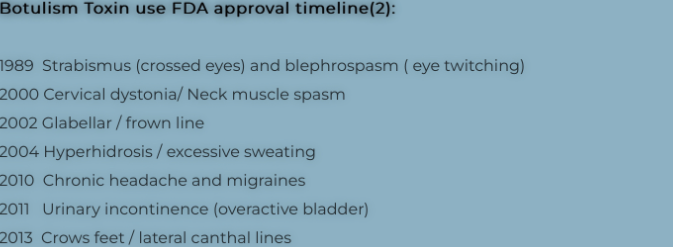When you think of Botox, chances are cosmetic applications come to mind.
Indeed, here at Refine Aesthetics, we offer Botox to smooth facial wrinkles such as crow’s feet and frown lines.
Yet, Botox has a far-reaching history, and it’s still used to treat a number of different medical issues today.
Here’s a look into the fascinating origin story of Botox.

From Poison to Beauty
Clostridium botulinum is a bacteria that can be found in the environment and cause a rare but disabling paralysed illness.
Infection with this toxin can occur by ingestion leading to muscles being paralysed including the muscles required to breathe, which could lead to death.
It took over 100 years from the time it was first discovered to when it would be used safely administered for beauty purposes.

When was Botox first used?
The Botox drug is made from a toxin that the bacterium Clostridium botulinum produces.
It works by weakening or paralyzing specific muscles or blocking nerves.
It’s the same toxin that could lead to food poisoning if ingested, and in fact, that’s how Botox’s story begins.
Botulinum toxin was first discovered in 1897 after a group of Belgian musicians fell sick when eating the same smoked ham after performing at a funeral.
Following such an extreme event, the ham was sent for analysis to a professor of bacteriology, Emile van Ermengem, at the University of Ghent.
Dr. van Ermengem originally discovered the bacteria, but it was only later isolated and purified by US scientists during World War II.
Throughout the mid-1900s, the bacteria was further studied in the US, and finally, D.B. Drachman demonstrated the toxin’s paralysis effect while conducting animal studies in 1965.
In the 1970s, American ophthalmologist Dr Alan Scott began to investigate the toxin as a possible treatment for eye impairments.
In 1978, he injected the paralytic into a patient for the first time, in an attempt to treat the eye muscles after surgery for retinal detachment.
This experiment was successful and paved the way for other patients to receive it, including those who suffered from strabismus, or misalignment of the eyes.
Dr. Scott’s groundbreaking research led him to become known as the “Father of Botox”.
The Evolution of Botox
Doctors in other fields heard of Dr. Scott’s injections and soon began using them for other issues such as jaw-clenching and migraines.
But beyond addressing the root problem, these injections also came with an unexpected benefit: patients soon found that the fine lines around their eyes were also smoother afterwards.
The FDA originally approved Scott’s drug, OnabotulinumtoxinA, for therapeutic use in 1989.
In addition to treating strabismus, it was also used for blepharospasm, a condition in which the eyes lid twitches.
He sold the rights to the drug in 1991, and the new distributor, Allergan, rebranded to Botox the year afterwards.
Throughout the 1990s, Botox became known as a powerful tool for helping people maintain a more youthful appearance.
Doctors became increasingly skilled at using it for cosmetic purposes, and by 2002, the drug received FDA approval for cosmetic applications, including treating frown lines, crow’s feet, and forehead lines.
Today, Botox remains the only neurotoxin with FDA approval for various cosmetic applications.
It continues to be used to treat eye conditions, as well as those that cause muscle contractions, chronic migraines, overactive bladder, and severe underarm sweating.
Botox can also be used to strategically relax muscles in the face for wrinkle reduction, brow lifting, jawline slimming, and more.
Most recently, it may even be linked to reducing anxiety.

Is Botox safe to use?
Yes. The FDA approval means this as tests to make sure medicines/products are safe for use on humans.
When administered by a trained medical practitioner within safe doses it is a safe treatment.
The doses required for cosmetic purposes are very small compared to doses that would be required to cause life-threatening complications.
Does Botox cause cancer?
There is no evidence to suggest that Botox causes cancer.
There are relatively few causes of adverse reactions following Botox injections and most are not major or permanent conditions.
Also, compared to known carcinogens, Botox is administered in much smaller amounts and consumed less frequently.
How does Botox work?
Botox can be used to stop muscles from contracting.
Muscles contract when they receive a nerve signal to do so.
Botox blocks this signal.
It also blocks signals for pain and inflammatory reactions making it useful e.g. migraines, etc.
It starts to work after 1-4 days and after 120 days the effects will wear off.
The body regenerates new nerve endings so the nerve signals can be received without the botulism toxin block(2).
Because of this action, it can be used for aesthetic purposes to soften wrinkles as stopping muscles from moving causes less wrinkling/scrunching of the skin.
Its other uses are for excessive sweating, teeth grinding, and migraines to list a few.
Who should not have Botox?
- Trying to conceive women/pregnant or breastfeeding
- Treatment site infection
- You have a neuromuscular condition e.g. myasthenia gravis
- Taking certain medications e.g. Gentamicin antibiotics
Botox has many many uses, more being found all the time. It’s actually a wonder drug.
It has been through so much research and testing and has a great safety profile.
It’s certainly come on a long way in 100+ years.
I think it’s absolutely fabulous!!!
If you’re interested in finding out what Botox injections could do for you, please book a consultation, you can either message or book online.
